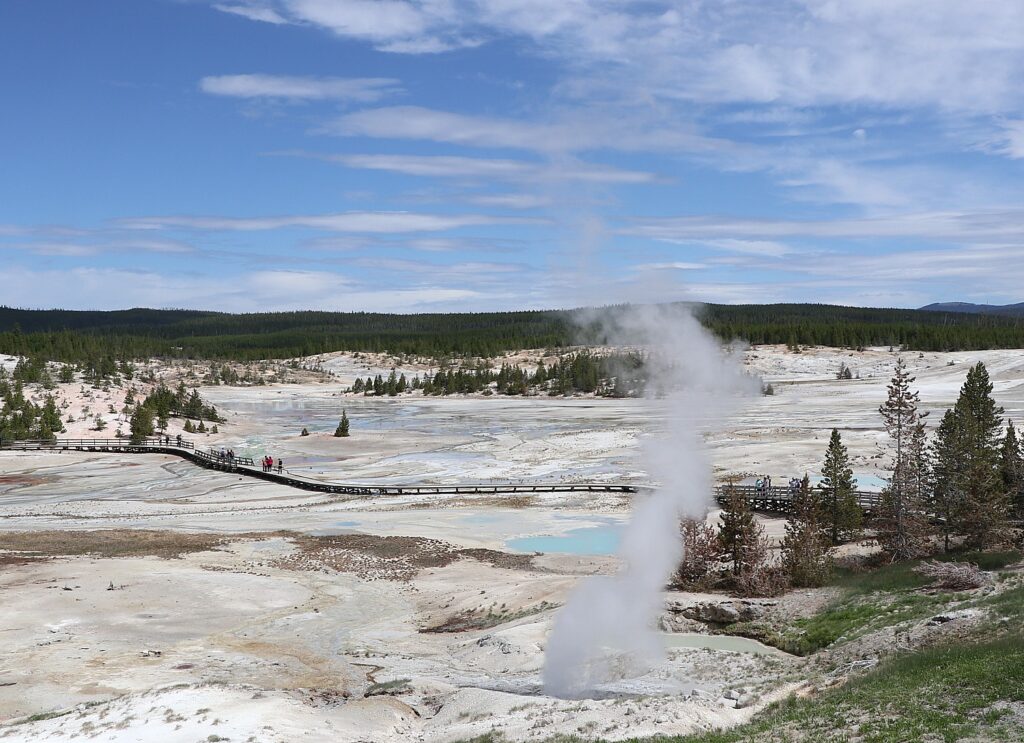
By Karen Rubin, Eric Leiberman, David Leiberman & Laini Miranda
Travel Features Syndicate, goingplacesfarandnear.com
What makes Yellowstone National Park so astonishing isn’t the vast expanse of pristine wilderness but the natural features that are, to be frank, other-worldly, even surreal.
There are the spectacular attractions that have existed for hundreds of thousands of years, even millions of years and are dependable – the Old Faithfuls – and then there are the serendipitous surprises that are unique, never happened and never will happen that might be around any corner. Like coming upon a bison leaping into the air to grab a bird in flight. And the utter astonishment when you first come upon the neon colors of a boiling landscape.
But even the geologic features are constantly changing. And it happens before your eyes.
Yellowstone is essentially a supervolcano fueled by a hot spot in the earth’s mantle that causes magma to be closer to the surface than normal. The ongoing thermal activity fuels the park’s geysers, hot springs, fumaroles and mudspots and creates the hypnogogic colored landscapes that makes Yellowstone so unique in the world. Who knew there is more thermal activity in this relatively small section than any other place on earth?
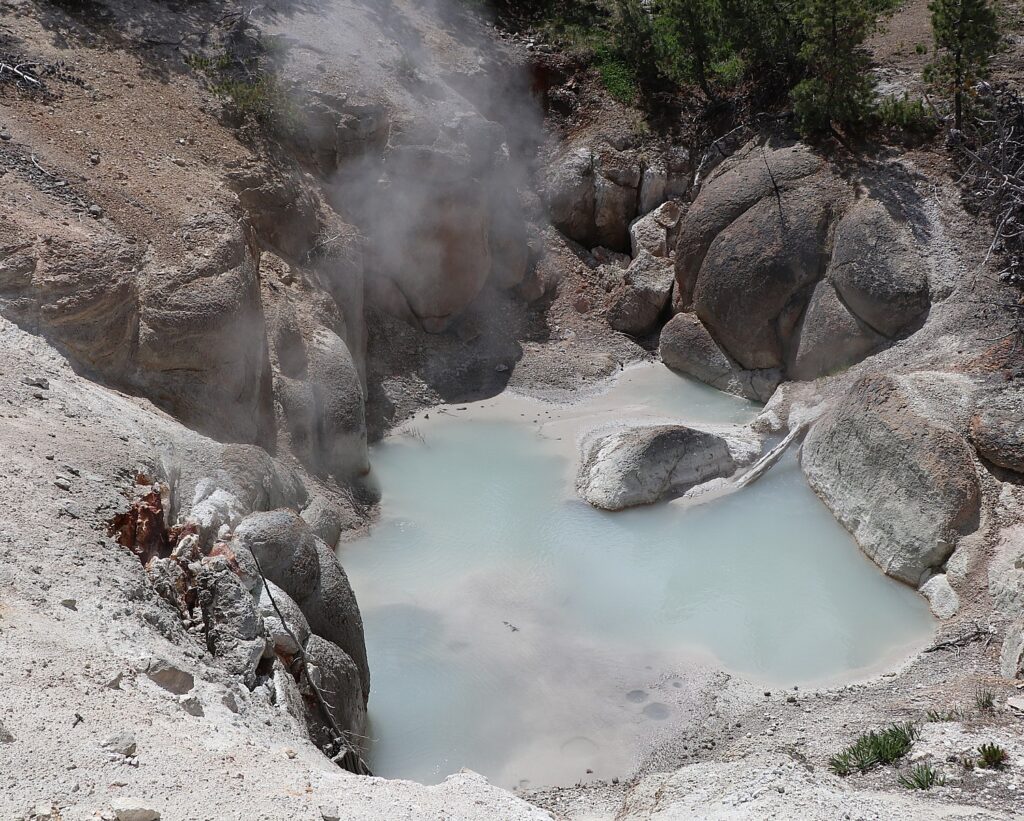
Indeed, formed by massive volcanic eruptions– the last about 631,000 years ago when the center of what is now the park collapsed, forming a 30 x 45-mile caldera, Yellowstone National Park has the most thermal geological features of any place in the world.
You go from one “I can’t believe this is real” sight to another in Yellowstone National Park. It is a constant string of “oh my god-s” that take your breath away.
Yellowstone is so vast (and so popular) that it is beneficial to have a plan and to figure out roughly the logistics (taking into account serendipitous detours and changes) since it can take 45 to 60 minutes just to get into the park to some of these most popular features.
So we set out to break up our visit by staying two nights each in three different locations: Gardiner (North entrance), West Yellowstone (West entrance) and Jackson (South Entrance) – which we find on hotels.com and booking.com (all the in-park hotels, lodges, campgrounds were under capacity restraints and already booked). Even our plan to enter the park through the Northeast entrance, putting us into the Lamar Valley (one of the best places for early evening wildlife viewing), enables us to see a whole region of the park at an ideal time.
We depart the Red Reflet Ranch in Ten Sleep, Wyoming, in the afternoon for the five-hour drive by way of Cody through Cooke City-Silver Gate, into the Park. We choose our route – the Chief Joseph Scenic Byway – deliberately for the stunning scenery and historic importance in the Nez Perce War, as described at the Dead Indian Rock Overlook. We stop in the charming town of Silver Gate, just outside the park, to get some elk brat on a bun from a food truck, while watching a bison that has wandered right up to one of the cabins.

We drive caravan style – David and Laini in their tripped out Subaru Forester converted into a camper van which they have already driven 2200 miles from New York and will subsequently travel 8300 miles on their coast-to-coast road trip, and Eric and I in a Mazda SUV we rented at Enterprise Rent-a-Car in Casper, Wyoming (lucky to have booked months ahead since they were out of cars).
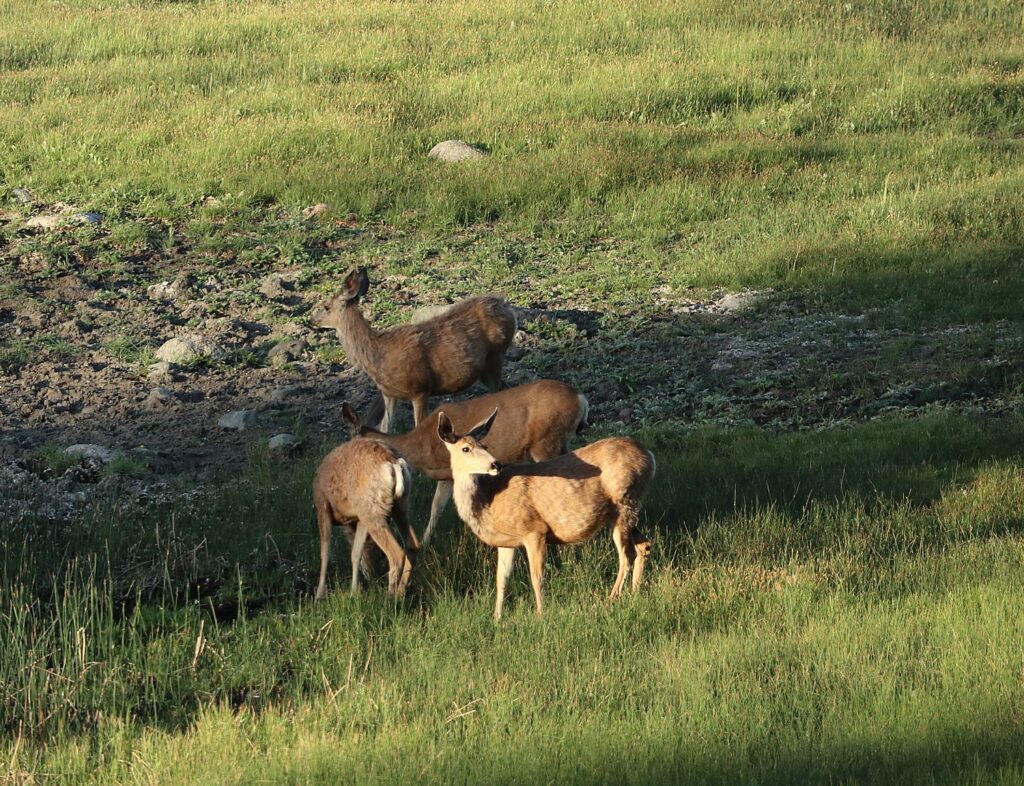
The route brings us through the steep Absaroka Mountains, following the Soda Butte Creek as it flows down to the Lamar River into Yellowstone National Park through the Northeast entrance, and through the Lamar Valley just before dusk – prime time and optimum place to see wildlife.
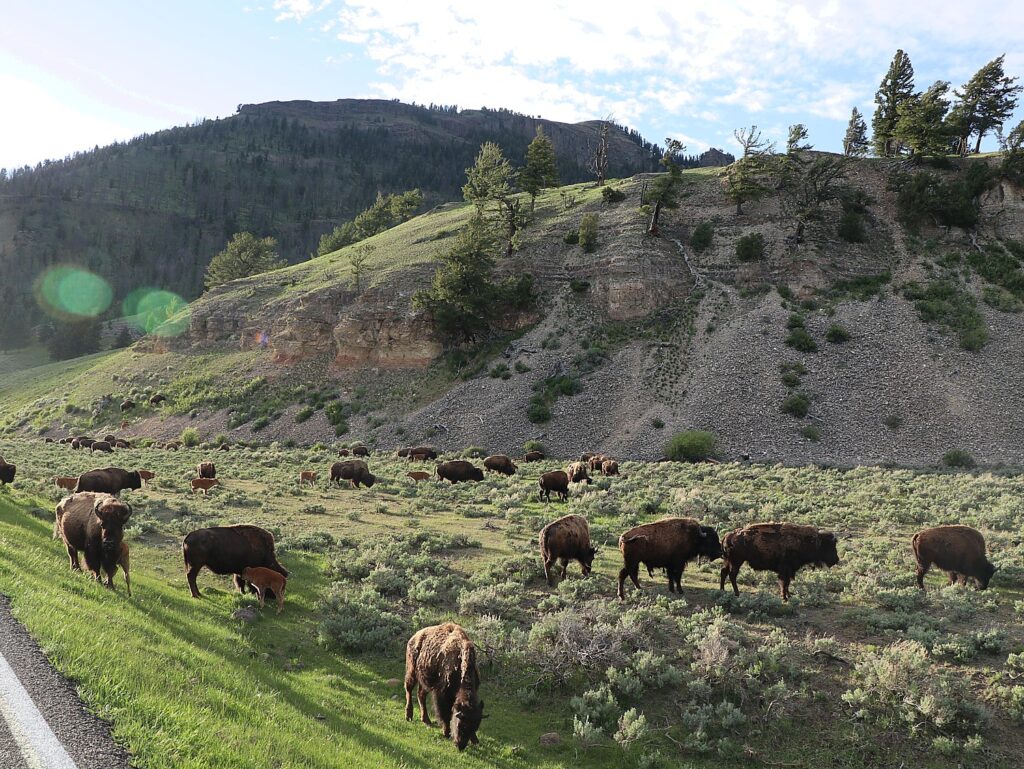
The Northeast Entrance, considered the “quietest” of Yellowstone’s five gateways, is historic. It was constructed in 1935 in a rustic style which “subconsciously reinforced the visitor’s sense of the western frontier… not only the physical boundary, but the psychological boundary between the rest of the world and what was set aside as a permanently wild place.”
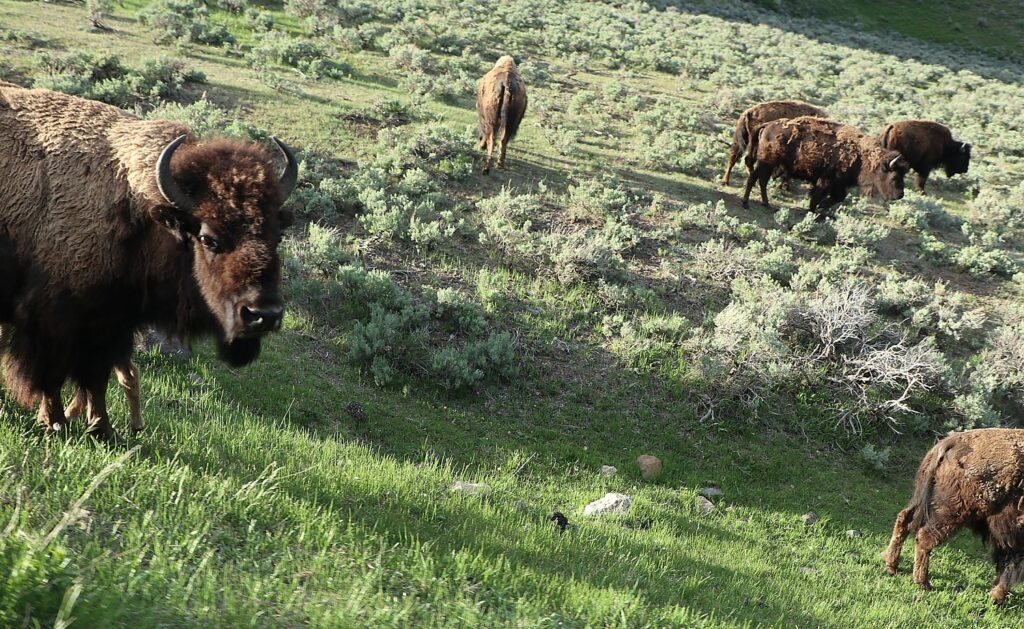
The Lamar Valley is a distinctive attraction in Yellowstone, considered one of the best places to see wildlife when they are most active, in the early morning and early evening. It is a large, wide-open valley carved by glaciers about 21,000 years ago which left boulders and ponds that dot the landscape and attract the wildlife.
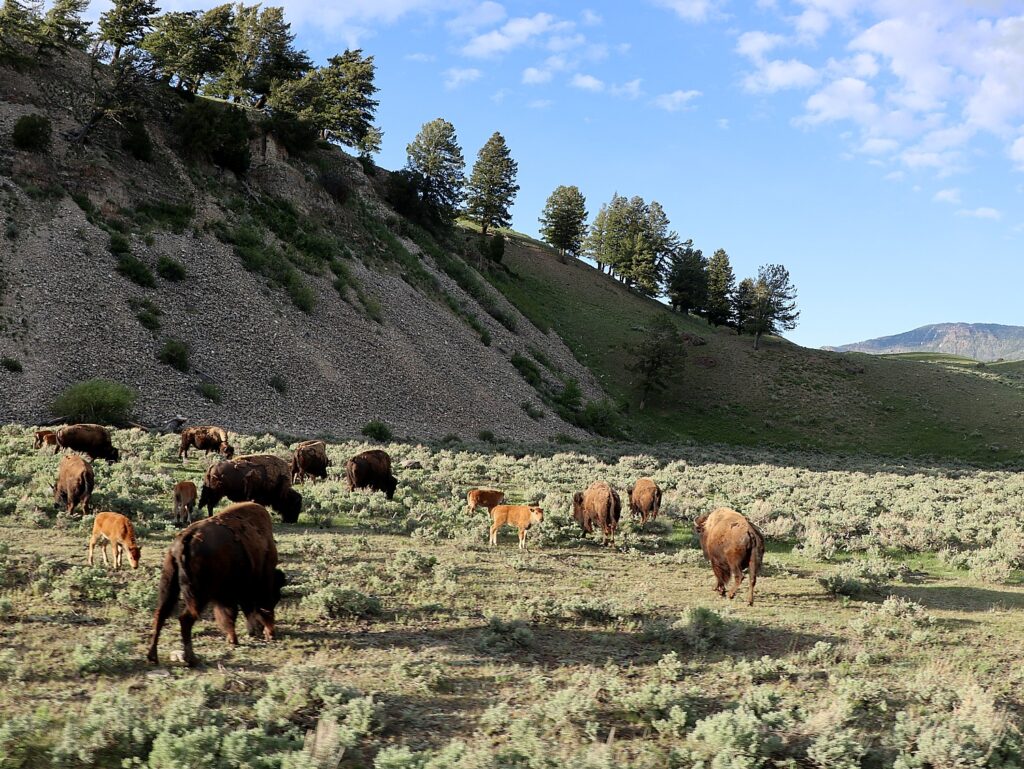
The Lamar Buffalo Ranch was established here in reaction to the near-extermination of bison throughout the West in the 1800s. It was the first effort at intensive management to preserve a wild species. Fed and bred here, as the herd grew in size, bison were released to breed with the park’s free-roaming population. Bison from the ranch were also used to start and supplement herds on other public and tribal lands.
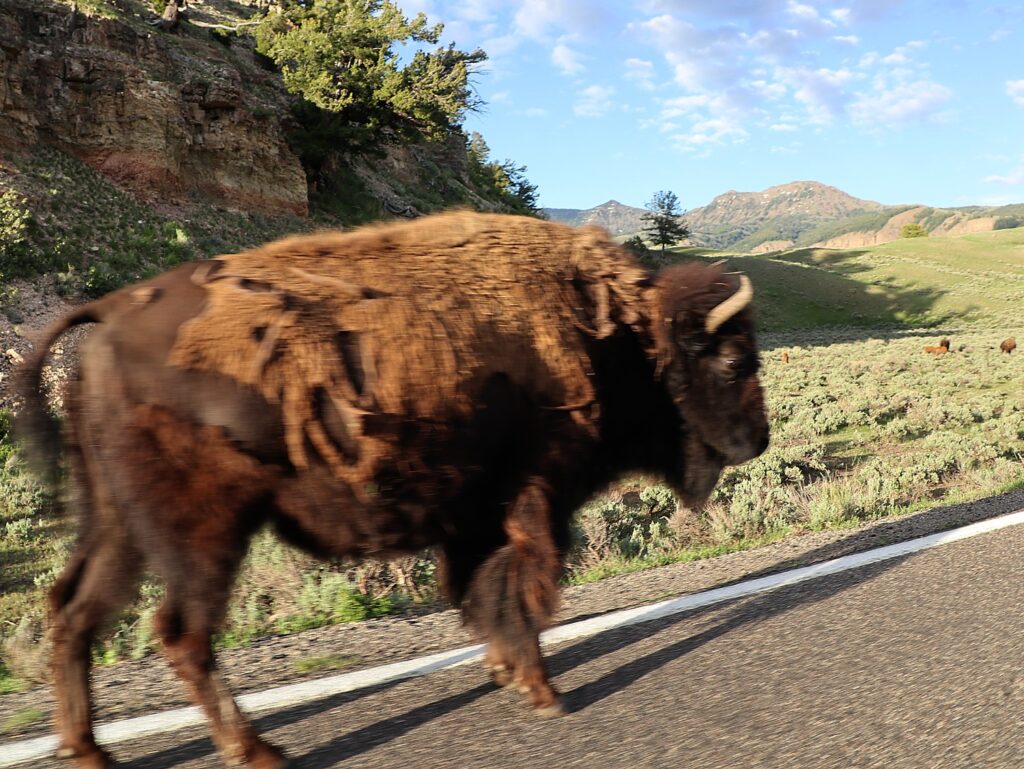
Sure enough, we are stopped frequently as herds of bison with their new calves, assert their right to cross the road or just stop in the road, seemingly oblivious to the cars. A ranger comes along and we are amazed at how he uses his siren but also actually maneuvers his car to nudge a bison out of the way so the traffic can flow again. It is at this moment that Laini sees a bison literally leaping into the air and catching a bird in its mouth.
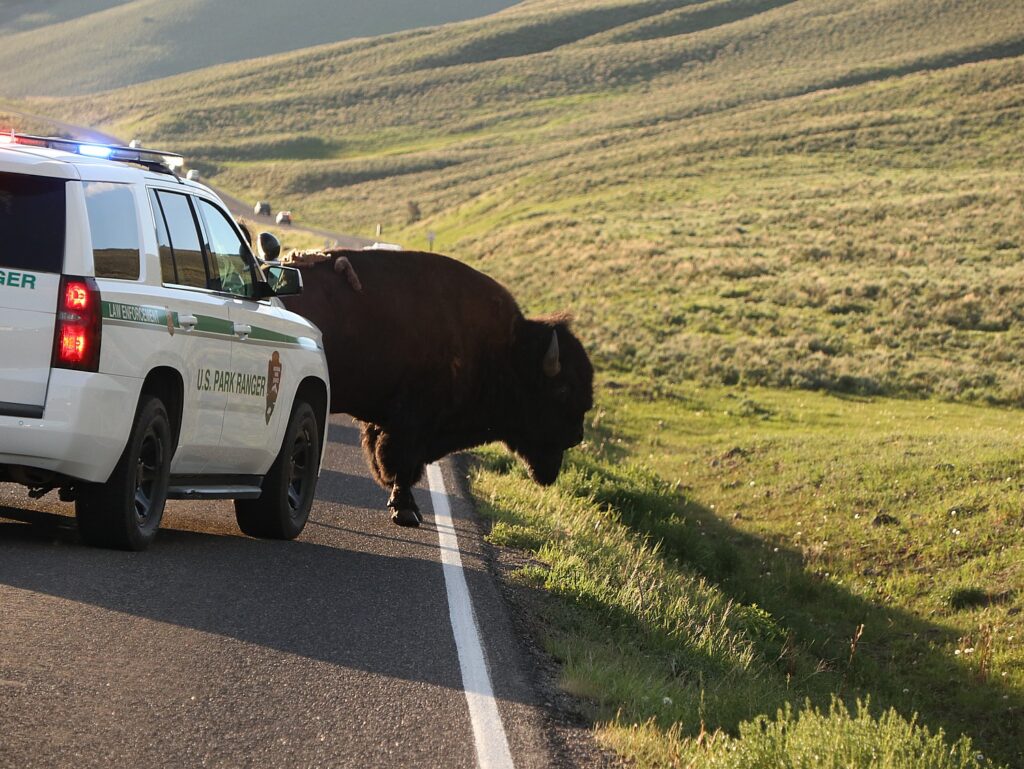
We settle in to our cabin at the 406 Lodge in Gardiner, perfectly situated just few blocks from Northeast Entrance, then 5 miles to Mammoth Springs, where we stay for two nights before moving on to West Jackson and then to Jackson, for two nights each.
Day One in Yellowstone
We enter Yellowstone through the North entrance at Gardiner (much less crowded than other park entrances, and the only entrance open year-round). The historic Roosevelt Arch (named for President Theodore Roosevelt, who dedicated the arch by laying the cornerstone in 1903 and was responsible for creating the national parks system) is 50 feet high and built of local columnar basalt. Within the arch is engraved the iconic statement, “For the benefit and enjoyment of the people.” This also serves as a reminder that Yellowstone was the first national park in the United States and the world, a philosophical statement of national purpose.
The road leading into the park from this entrance leads visitors along the Gardner River and up nearly 1,000 feet to Fort Yellowstone (where the US Army was based from 1891 to 1913) and Mammoth Hot Springs, the first visitor area to be developed in the park. It offers the historic Mammoth Hot Springs Hotel and Cabins, Albright Visitors Center, gas station, ice cream and general store and a lovely picnic area which also serves as a meeting area for elk.
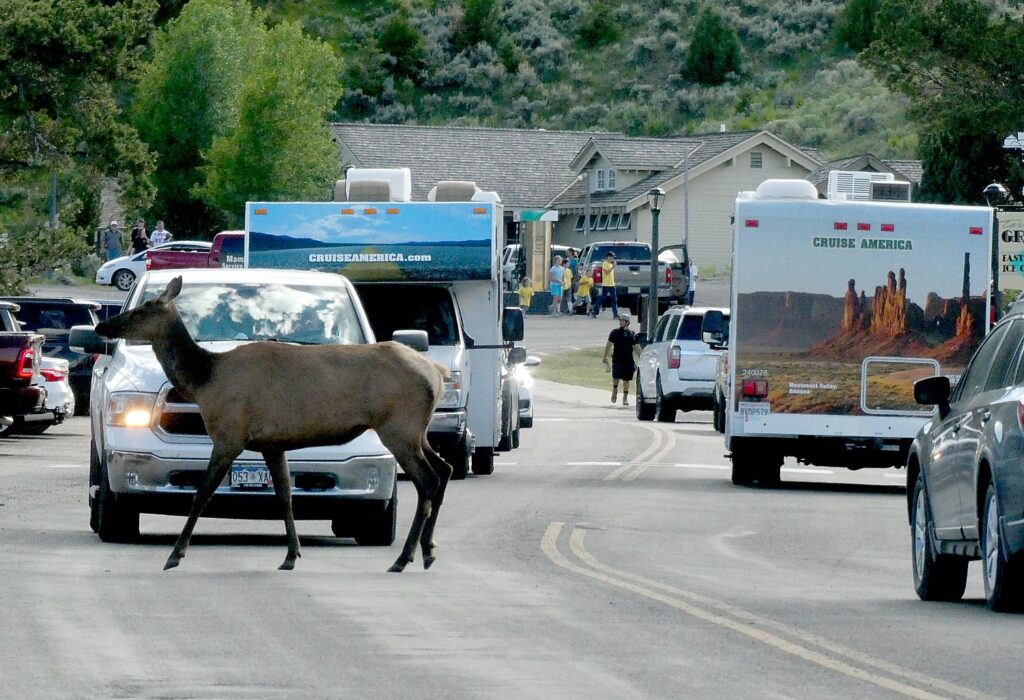
We immediately come upon the Mammoth Hot Springs, our first “attraction” in the park. The light is fairly dull when we arrive and we consider just blowing passed, but then we decide “no time like the present” and we can return on our way back if we like.
Best idea ever, because in just a few moments, the sun comes out, causing the rocks to glisten as steam rises. The textures, rolling shapes of water-worn rock, the patterns. Astonishing.
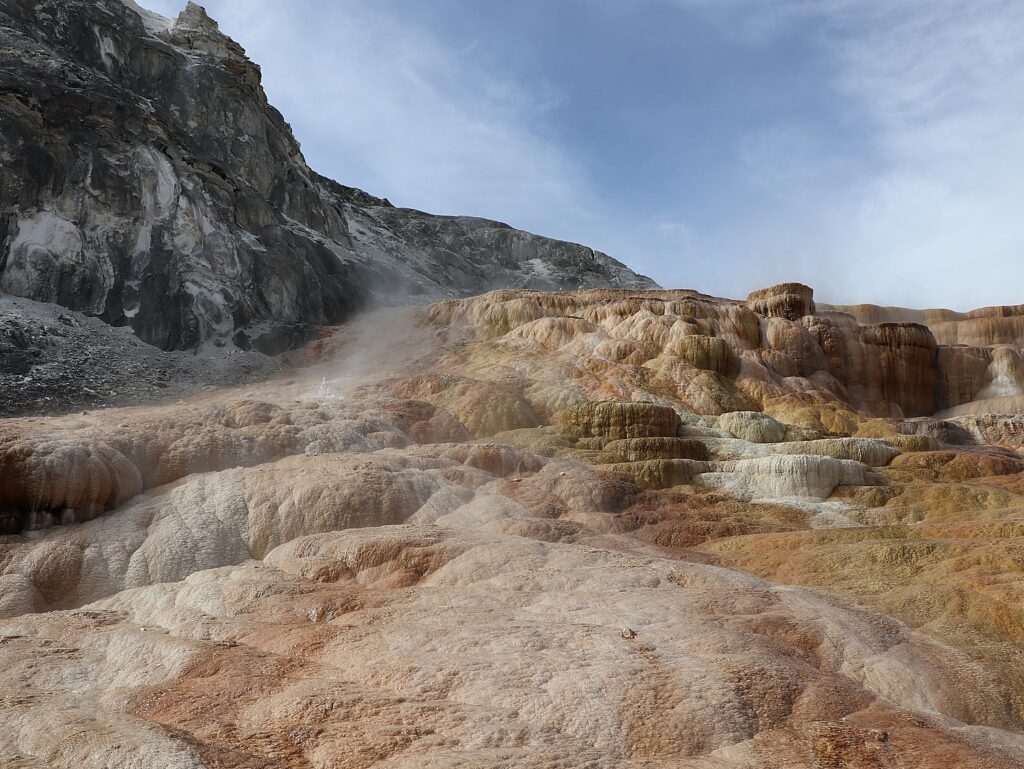
You walk a boardwalk up and around the formation, a massive hot spring complex of travertine terraces, considered one of the world’s best examples of hot travertine deposits. It is also one of the most dynamic hydrothermal zones in the park – its characteristics are constantly changing – which means that as you walk through, you are watching the process unfold before you. Even more intriguing is that the volcanic heat source for the Mammoth Hot Springs remains a mystery: Is it the large magma chamber underlying the Yellowstone Caldera, or perhaps a smaller heat source closer to Mammoth?
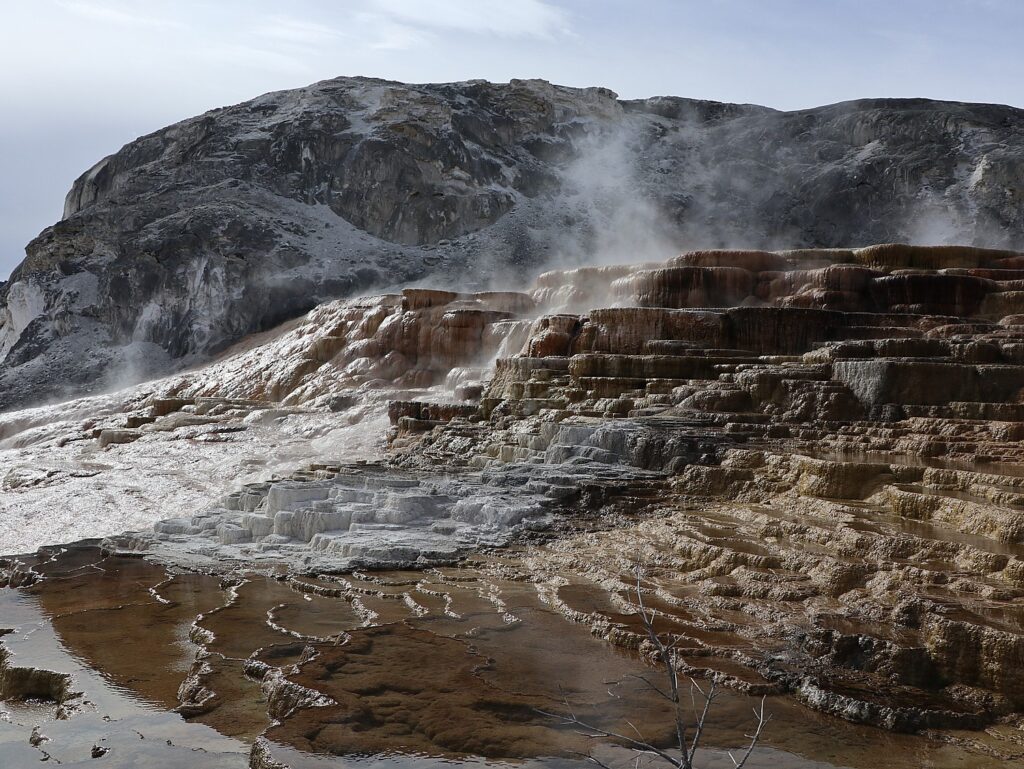
A network of fractures and cracks forms the “plumbing system” in Mammoth so underground hot water can reach the surface. “Small earthquakes can keep the plumbing open,” the notes say.
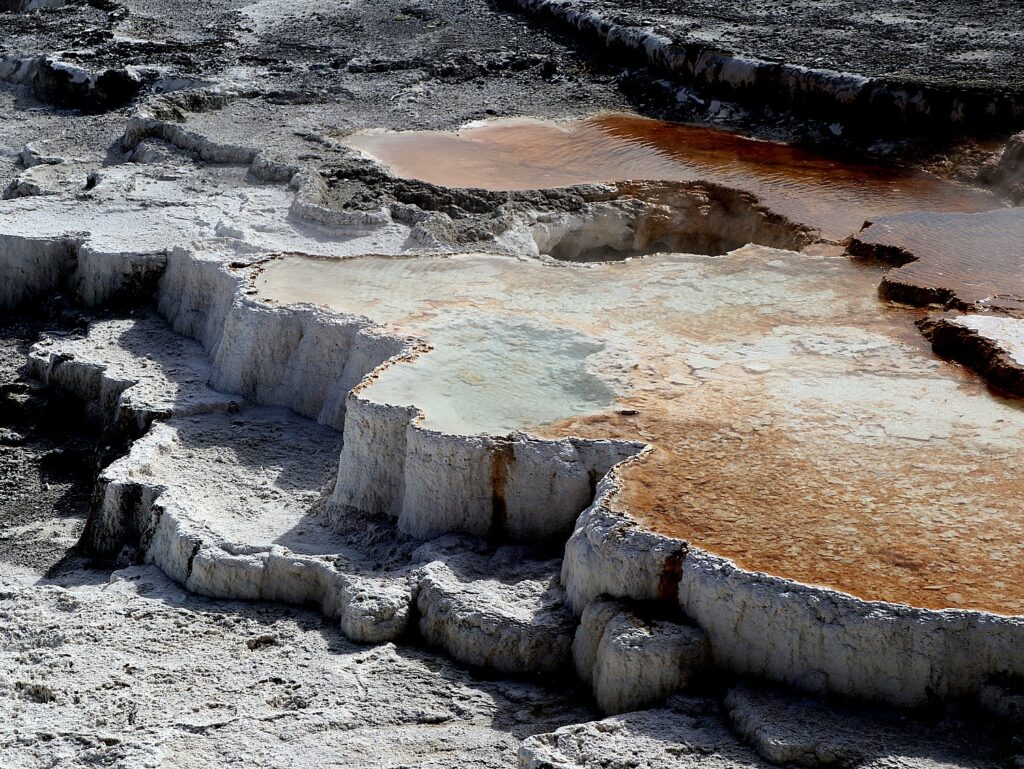
Limestone, deposited here millions of years ago when a vast sea covered this region, provides the final ingredient. Interestingly, while limestone is the dominant underlying rock here, rhyolite is the dominant rock in the other large hydrothermal zones of Yellowstone.

The dramatic colors we see are produced by thermophiles – heat-loving micro-organisms – which create tapestries of color where hot water circulates between the terraces, the National Park Service notes explain. Colorless and yellow thermophiles develop in the warmest waters; orange, brown and green grow in cooler waters. The colors change with the seasons.
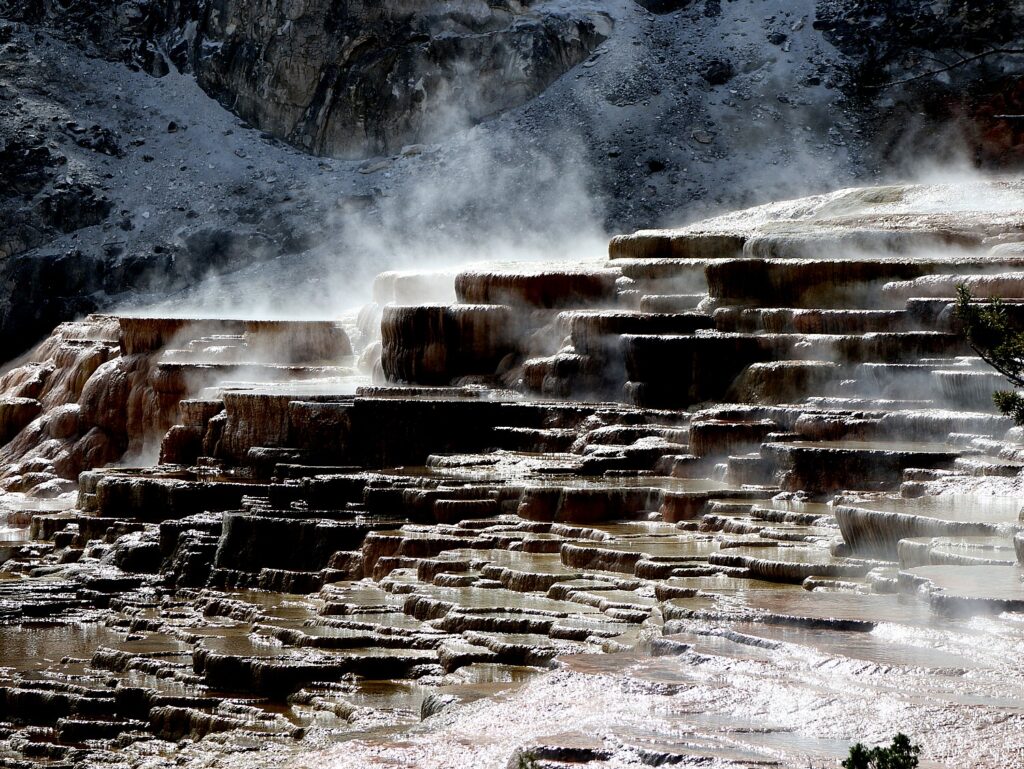
Most astonishing is that we are watching “living sculpture” – the terraces are being shaped by the volume of water, the slope of the ground and the objects on the way to the water. “They change constantly and sometimes overnight, but the overall activity of the whole area and the volume of water discharges remain relatively constant. Here, the rock is formed before your eyes.”
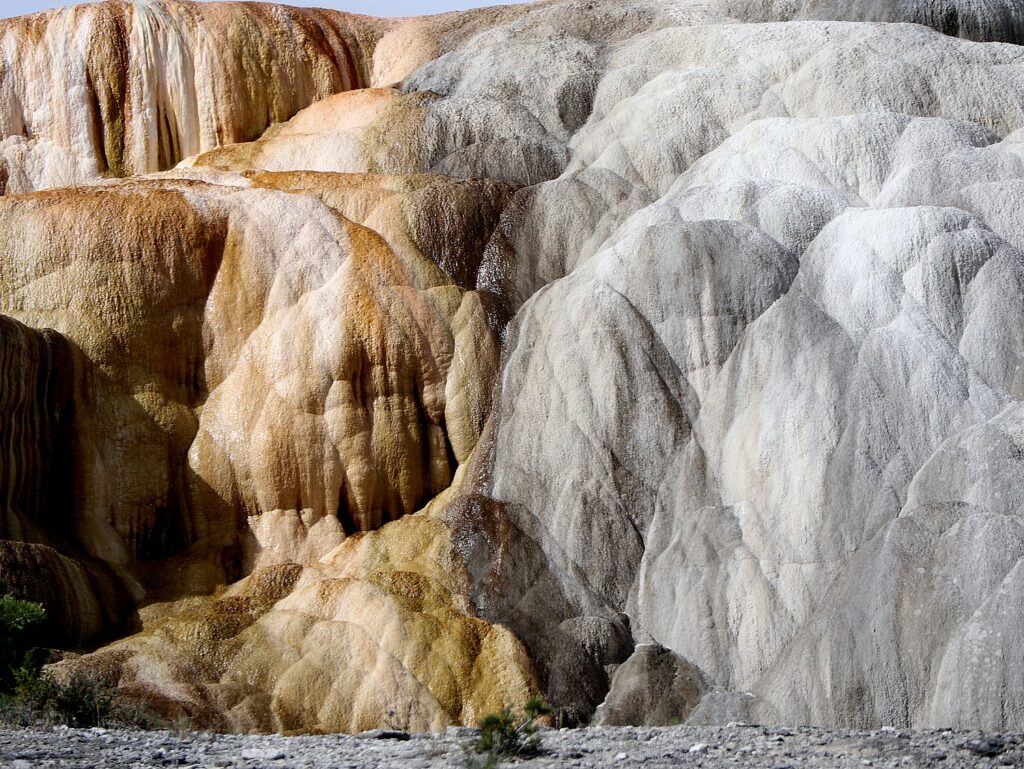
(We walk the boardwalk but there is a more extensive 3.5 mile-long Mammoth Hot Springs Area Trail.)
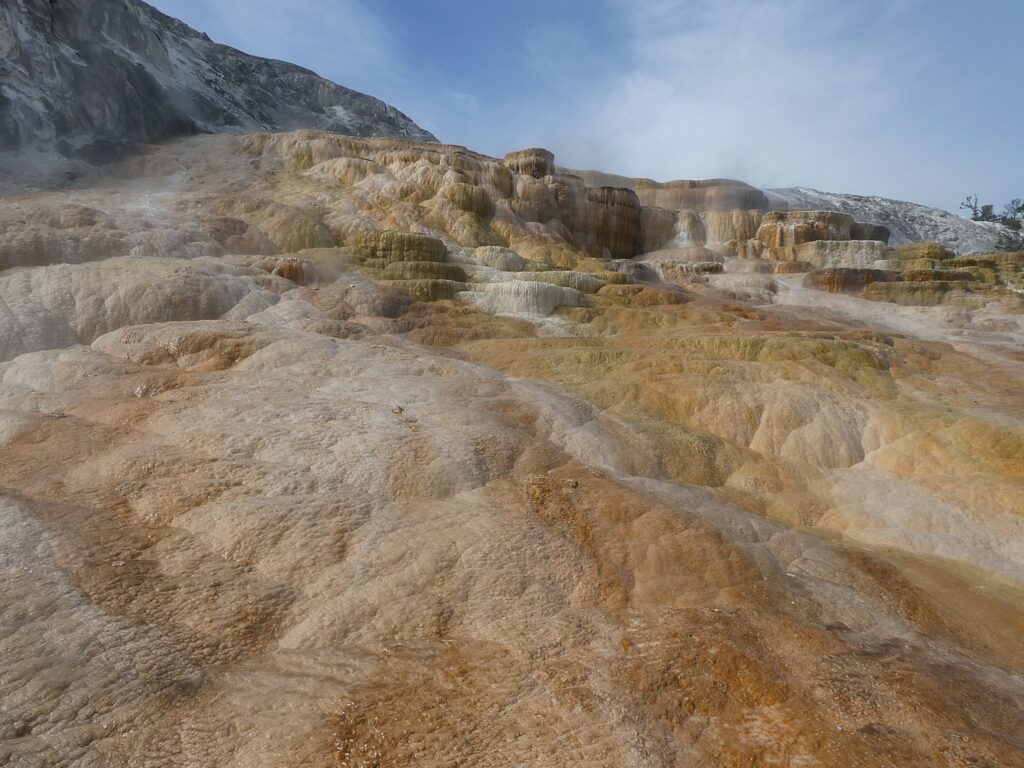
We head next to Norris Geyser Basin, passing by the Obsidian Cliff – a dramatic cliff of black glass formed in volcanic areas where the magma is rich in silica and the lava cools without forming crystals, which is unusual for how enormous the cliff is, 98 feet (we should have stopped). But we make a quick stop at Roaring Mountain, where steam emanates from multiple fissures. A sign says that the mountain has been heard to roar and could be heard as far as four miles away (no roaring today).
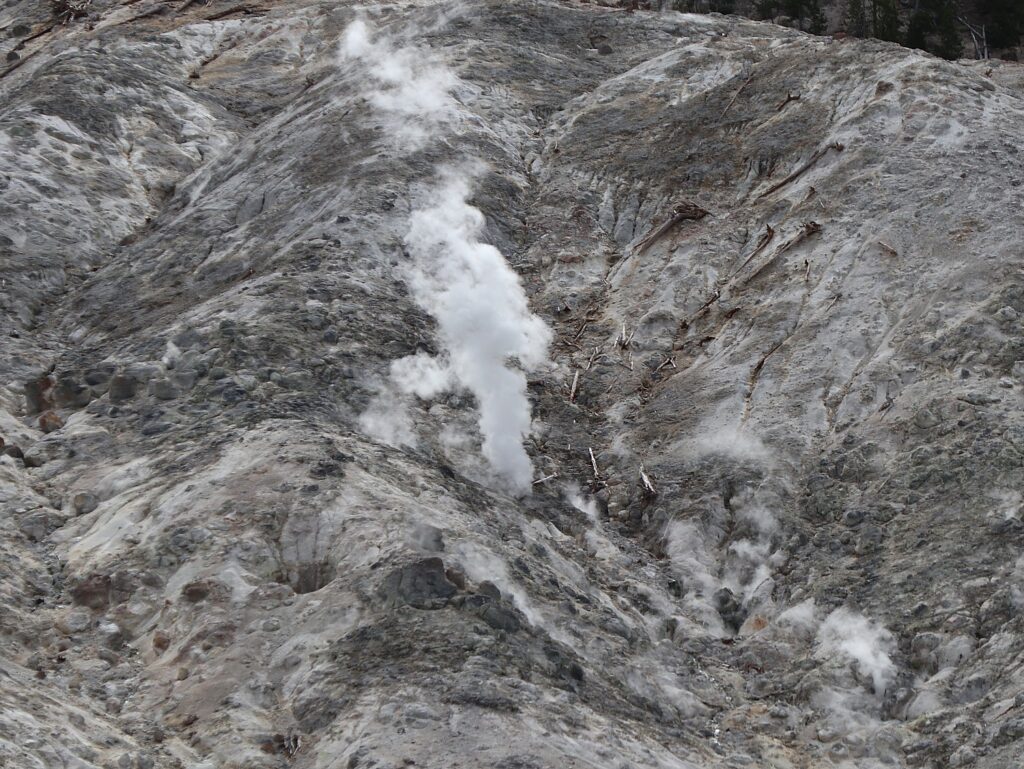
Norris Geyser Basin
Norris Geyser Basin, one of the park’s major highlight areas, is the park’s hottest, most dynamic geyser basin.
Named for Philetus W. Norris, Yellowstone’s second superintendent, Norris Geyser Basin is where you see the Steamboat Geyser, believed to be the tallest active geyser in the world, shooting water and steam more than 300 feet high during a major eruption.

The scene when you walk down from the Porcelain Terrace overlook to Norris Geyser Basin is striking.
Norris Geyser Basin has many acidic hydrothermal features and stunning colors – due to combinations of minerals and thermophiles. Silica or clay minerals saturate acidic water to create a milky white appearance; sulfur presents pale yellow; iron oxides, arsenic and cyanobacteria the red-orange colors; another thermophile glows, while another thermophile appears purple to black where exposed to sun, but bright green beneath.
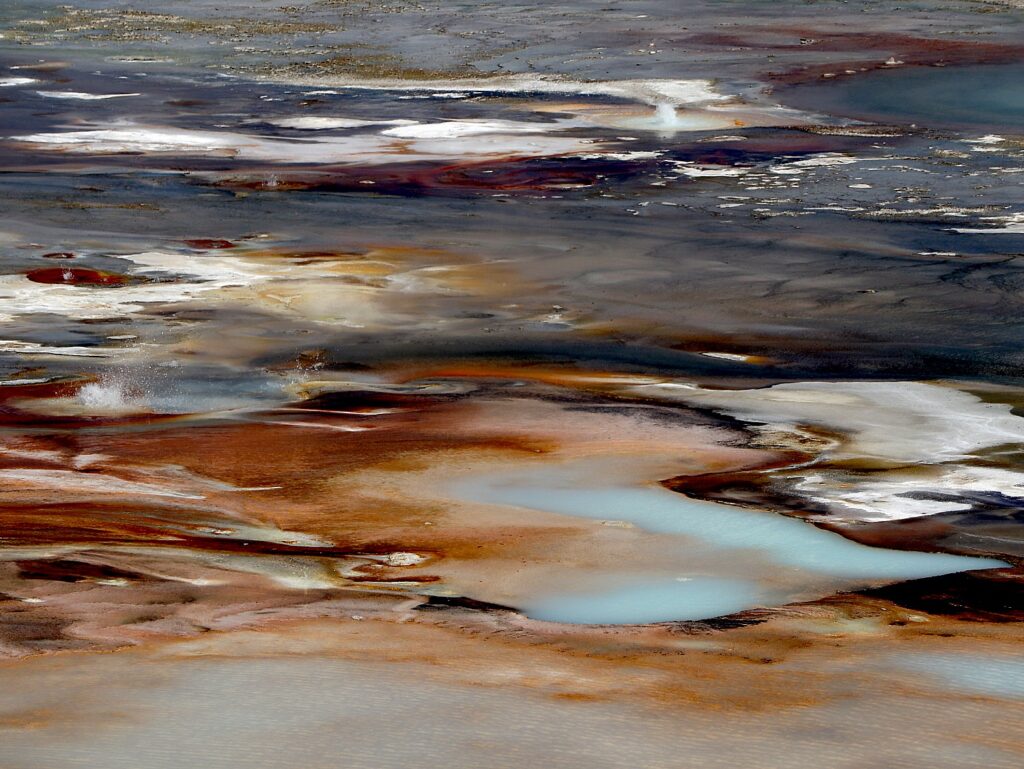
We walk the 1.6 mile-long boardwalk loop through the Porcelain Basin thinking we will return to do the longer, two-mile hike through the Back Basin later (that doesn’t happen).
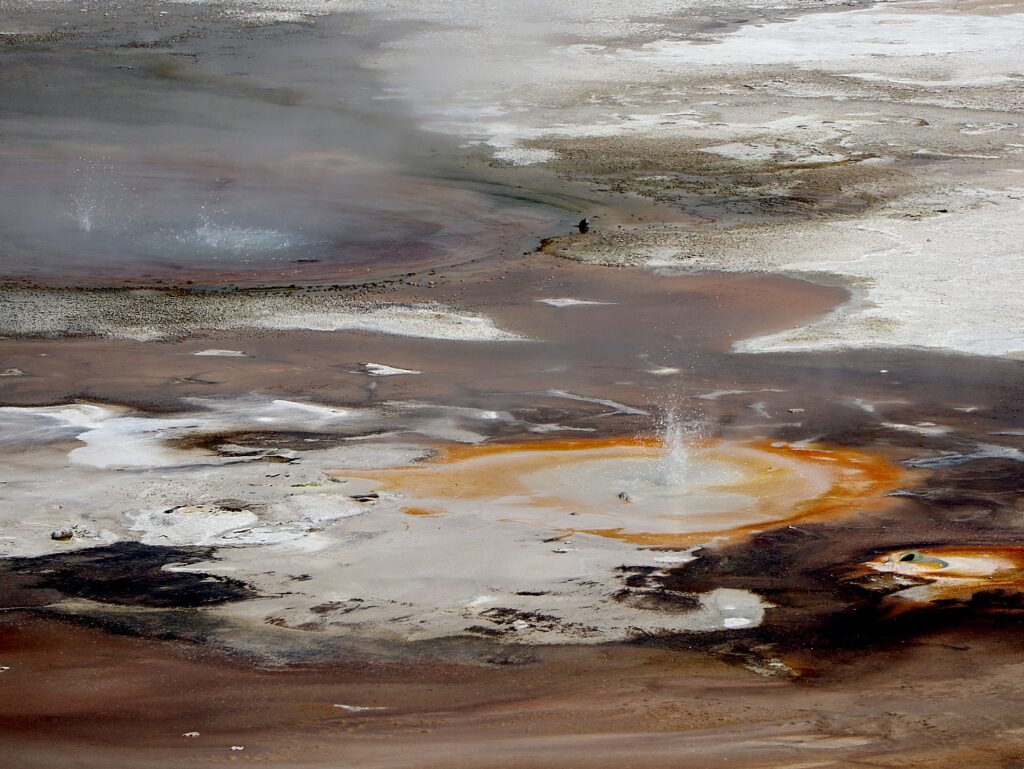
The National Park Service provides an online tour – as poetic as it is scientific – which you can use as you walk around (https://www.nps.gov/yell/learn/photosmultimedia/norris-geyser-basin-tour.htm):
Porcelain Terrace Overlook: “Parts of the whitish rock-sheet before you pulsate from the pressure of steam and boiling water beneath them. A number of geysers and other features here have been born suddenly in small hydrothermal explosions. Some features are ephemeral, their activity lasting a few hours, days, or weeks. A few others have become relatively permanent fixtures in the scene,” the NPS notes.
“At Norris, geothermal ‘disturbances’ take place annually. No other thermal area in Yellowstone exhibits this phenomenon. Mysteriously, features throughout the Norris area undergo dramatic behavioral changes, literally overnight. Clear pools become muddy and boil violently and some temporarily become geysers. These disturbances often occur in late summer and early fall but have been observed throughout the year.
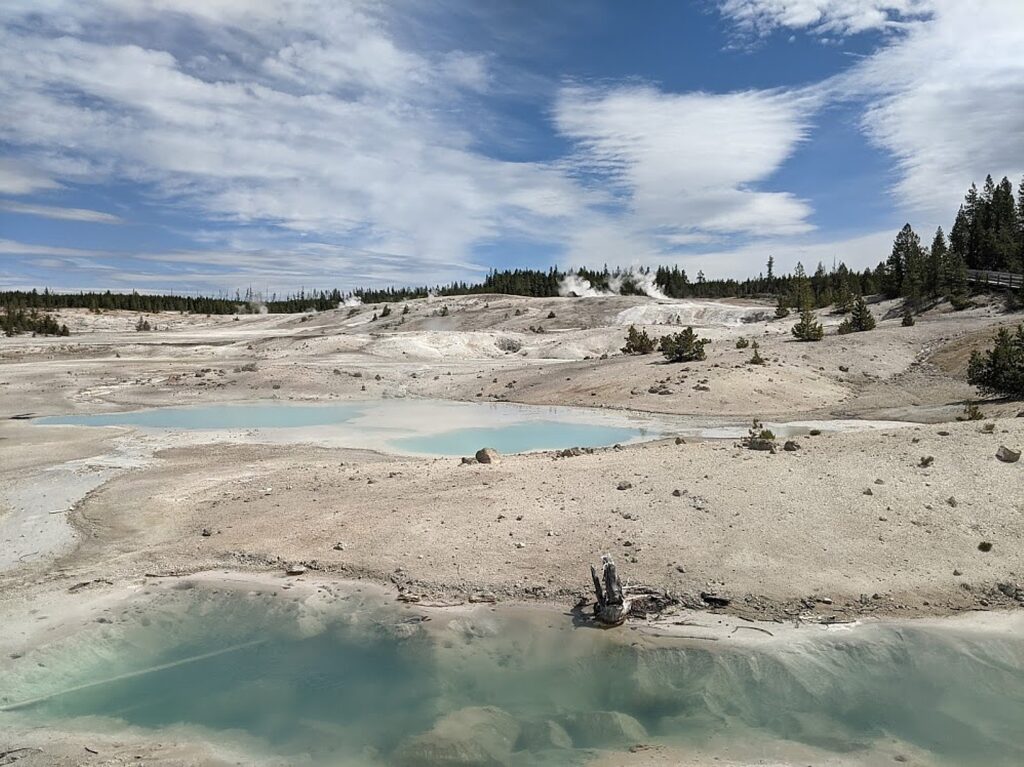
“Features that typically behave as geysers may display altered eruption cycles or temporarily cease erupting. New features may be created during a disturbance, although they seldom remain long-term attractions at the basin. Disturbances tend to last from a few days to more than a week. Gradually, most features revert to ‘normal’ activity.
“Why this happens is not fully understood. Further study will no doubt yield new clues that will help unravel the mystery of this phenomenon and lead to a greater understanding of the earth’s hidden geologic forces.”
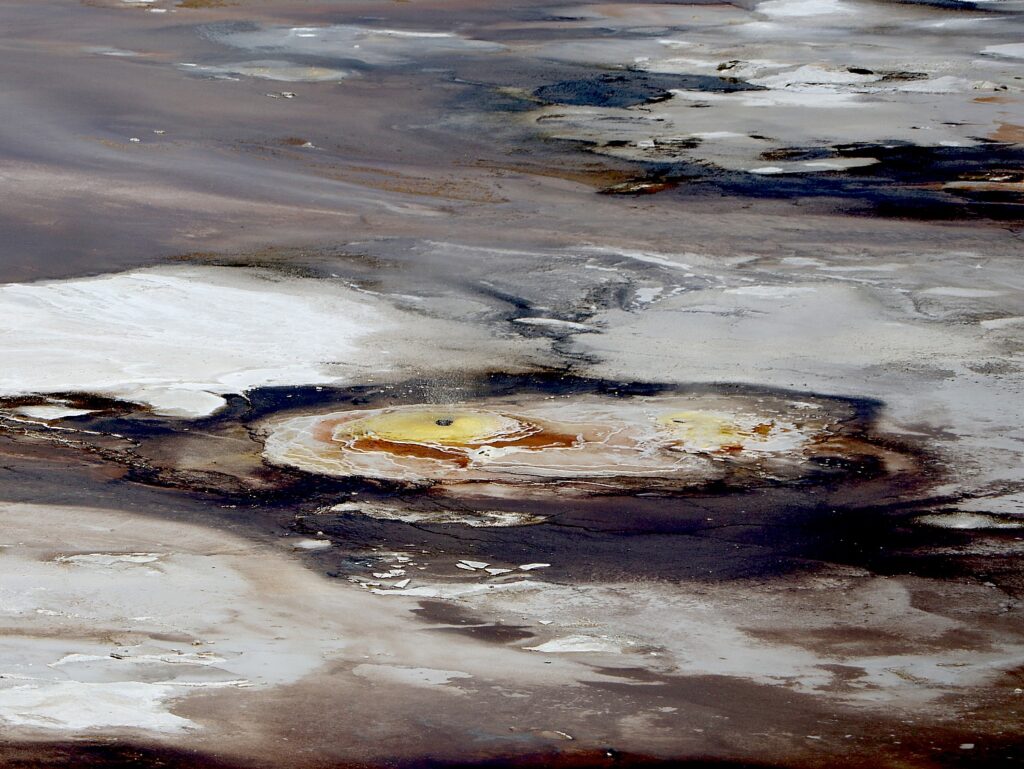
The tour details the main features: Black Growler Steam Vent, Ledge Geyser, Congress Pool, Porcelain Basin Hot Springs, Blue Geyser (last observed eruption was in 1997), Whirligig Geyser (the orange-yellow iron oxide deposits around Little Whirligig make it one of the most colorful features in Porcelain Basin; It has been dormant for several years), Whale’s Mouth and Crackling Lake.
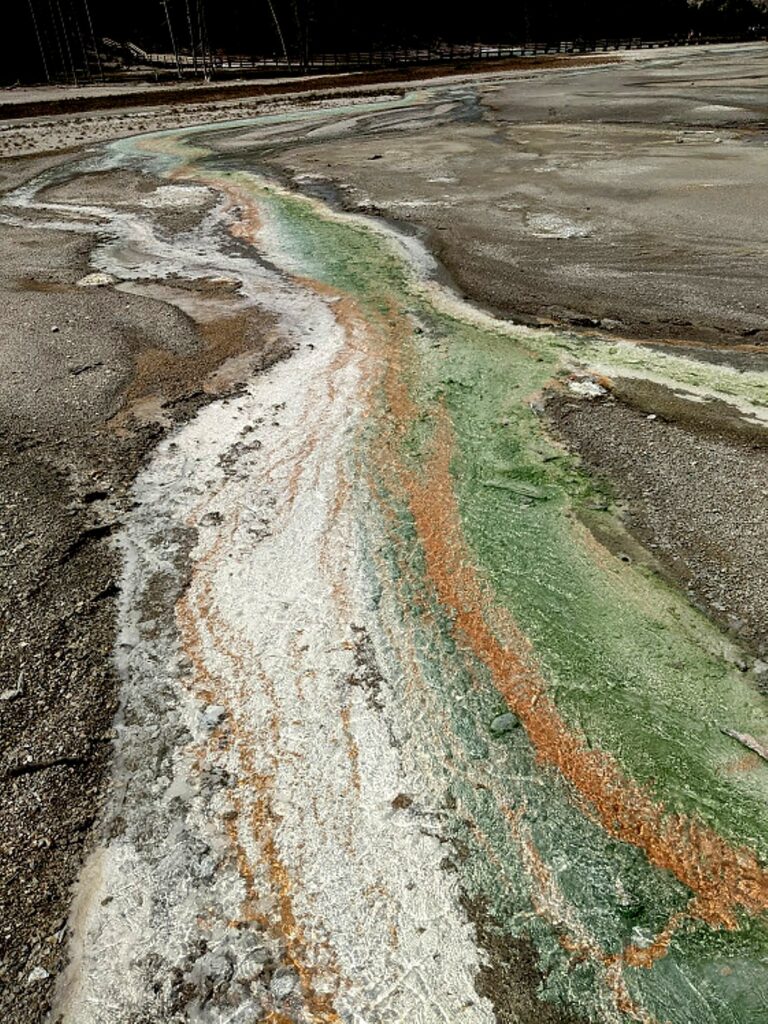
The colors are due to the living organisms that thrive even in the extreme environments of the acidic hot springs. Most interesting, the notes reveal, is that “These and other microscopic life forms are links to the emergence of life on earth billions of years ago. They are also a focus of research in the fields of medicine and criminal investigation. New tools for use in such complex areas as AIDS research and DNA ‘fingerprinting’ have been developed from the microscopic thermal organisms found in Yellowstone’s hot springs.”
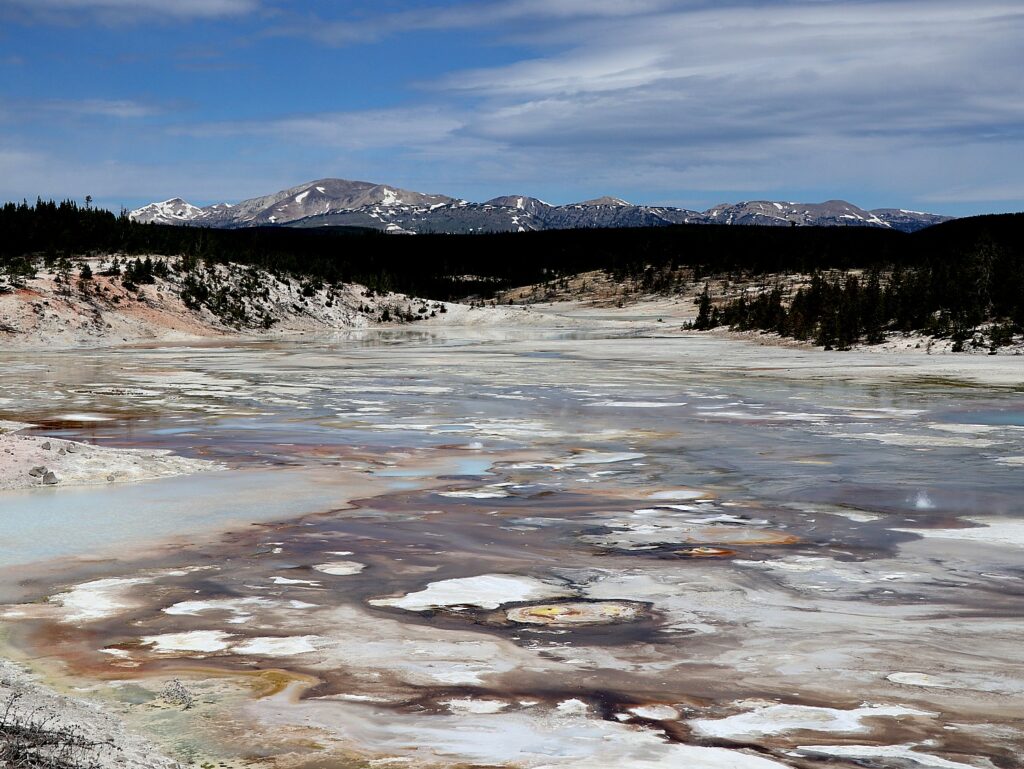
In contrast to the Porcelain Basin’s open terrain with hundreds of geothermal feature, the Back Basin trail is forested and the features more scattered and isolated.
At Norris Geyser Basin you can also visit the Museum of the National Park Ranger.
We have a picnic lunch in the parking lot (the Rangers caution against eating anything in the vicinity of woods because of bears).
Heading next to the Grand Canyon of Yellowstone, we come across a vast plain where a herd of bison are basking in sun. This is calving season and we see scores of calves with their mothers.
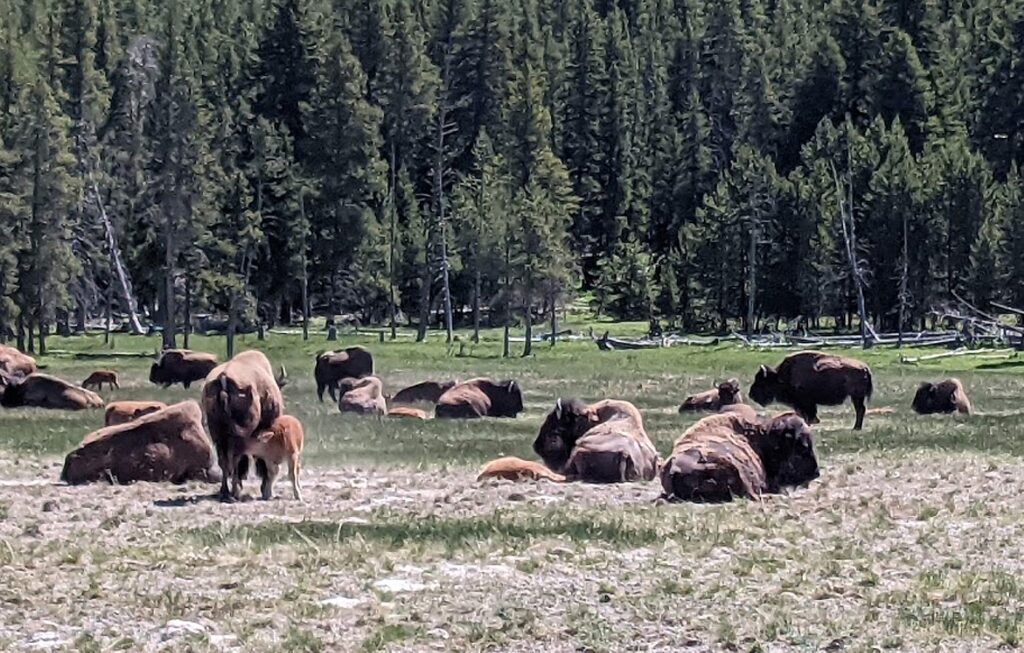
The Grand Canyon of Yellowstone
The Grand Canyon of Yellowstone is absolutely spectacular. The Lower Falls are stunning – in fact, it was this scene, painted by Hudson River School artist and conservationist Thomas Moran, that, it is said, convinced Congress to appropriate funding for America’s (and the world’s) first national park.
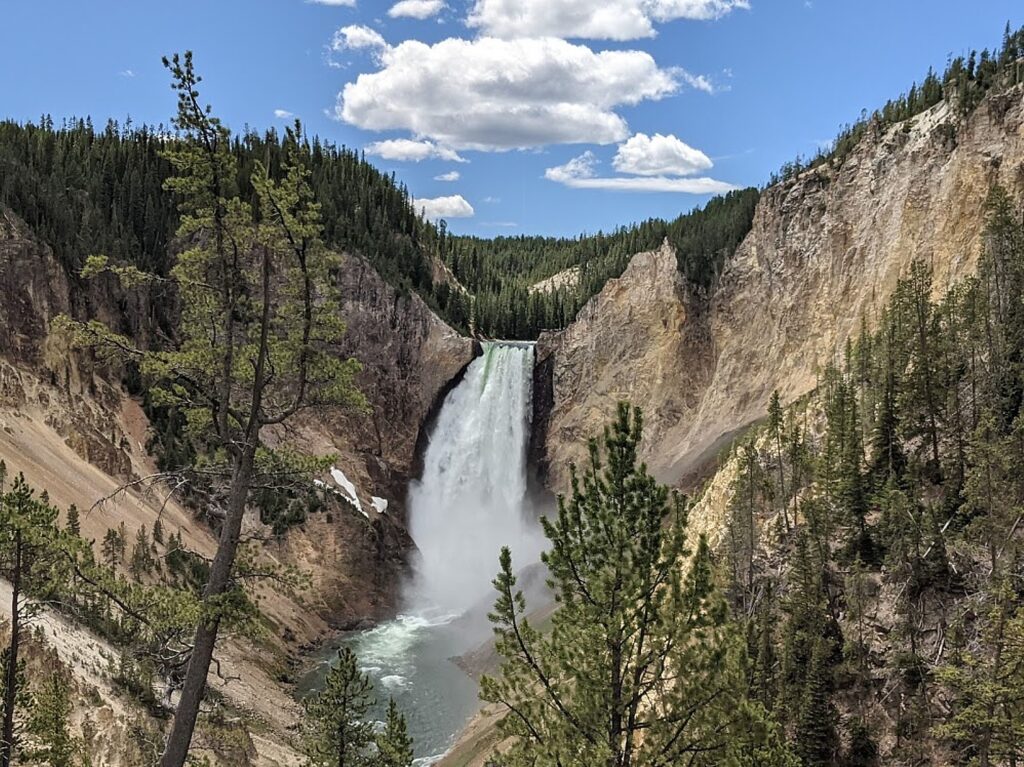
The Lower Falls are the more dramatic, dropping 308 feet (Upper Falls drop 109 feet). We get parking here (grab it!) and walk along the North Rim Trail for breathtaking views from Lookout Point (the vantage point for Moran, and not the misnamed Artist Point on the South Rim) and Grand View, and walking down staircases at two sites to get closer to the river. We walk on toward Inspiration Point but decide to return to the car instead and drive there (the park does a miserable job of telling you distance between points).
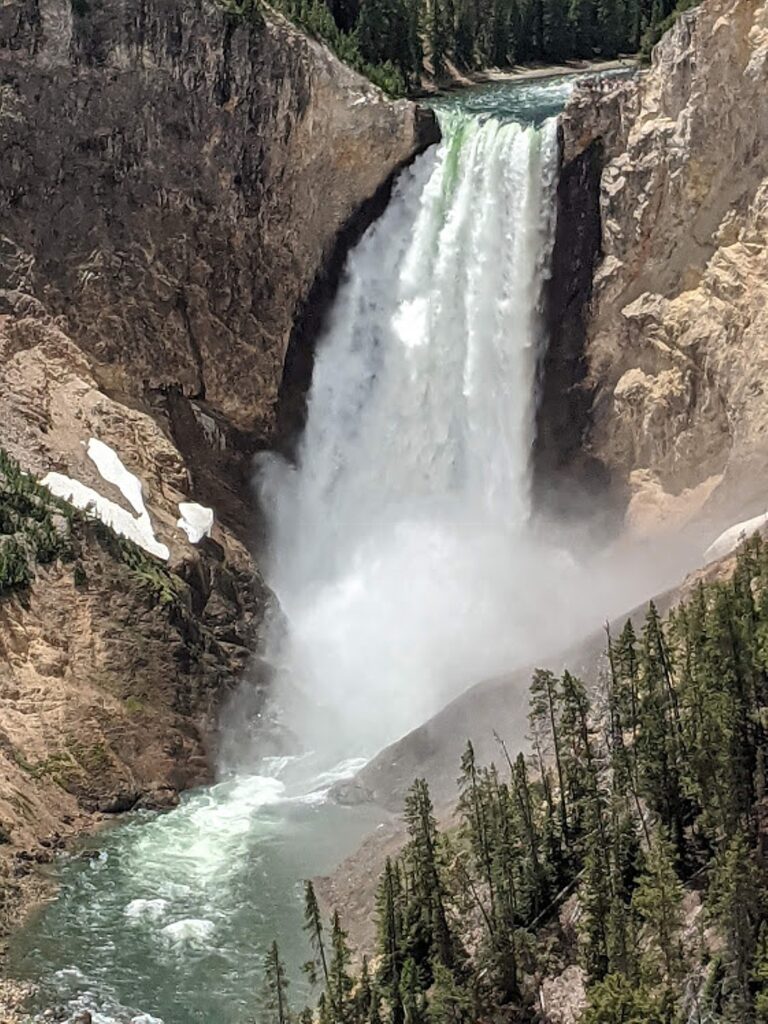
The Grand Canyon of the Yellowstone River extends 20 miles, is more than 1,000 feet deep, and ranges from 1,500 to 4,000 feet wide. Most striking are the color patterns in the rock – reds caused by oxidation of iron compounds in the rhyolite rock that has been “cooked” by the hydrothermal activity; yellows from sulfur. Looking down at some points, it is like a dizzying kaleidoscope.
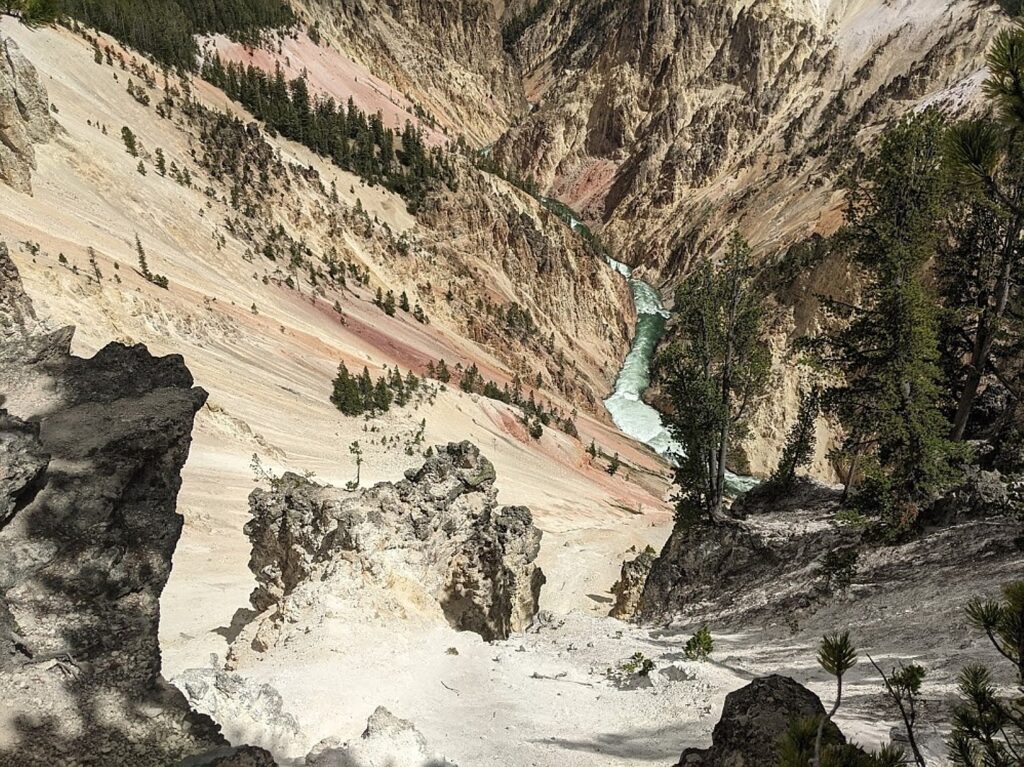
The Yellowstone River flows 671 miles from the Younts Peak in the Absaroka Mountains, to the Missouri River, near the Montana–North Dakota border. From there, the waters travel to the Mississippi River and on out to the Gulf of Mexico and the Atlantic Ocean. The Yellowstone River is considered the longest undammed river in the Lower 48 states.
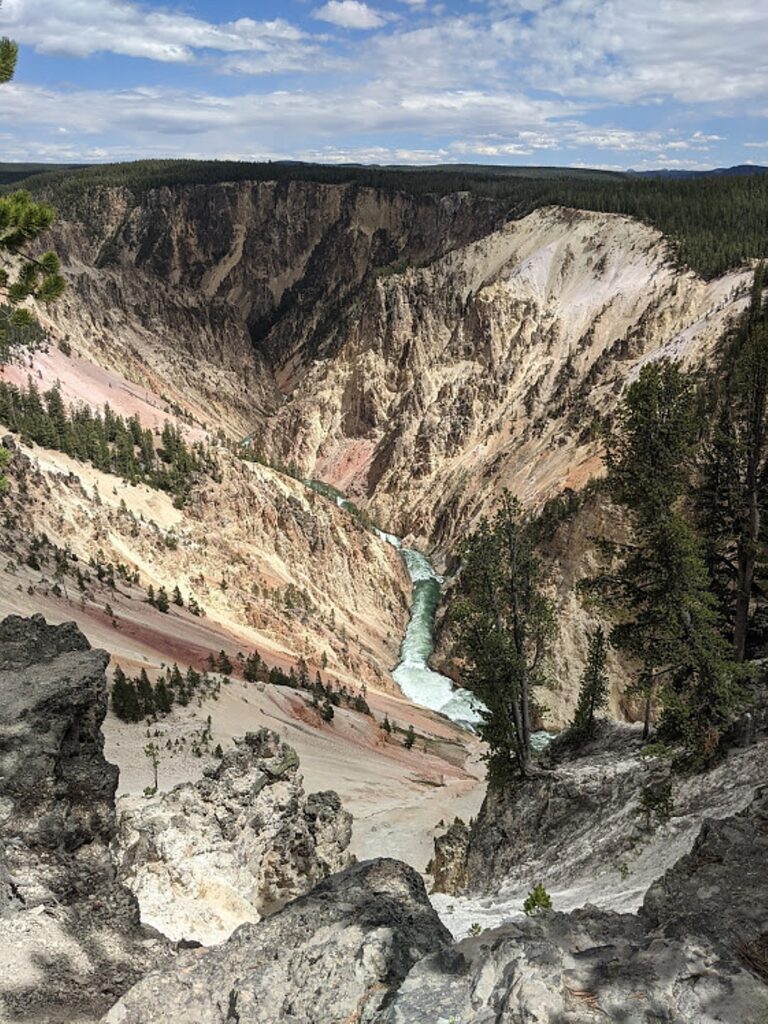
The North Rim Trail is utterly stunning at every step, taking you to multiple vantage points of both the Upper and Lower Yellowstone Falls, Crystal Falls and Inspiration Point, extending four miles. We do most of the trail. Definitely do the climbs down toward the river for the views back to the falls. (For a great description of the entire North Rim hike, https://www.hikespeak.com/trails/north-rim-trail-grand-canyon-of-the-yellowstone-river/)
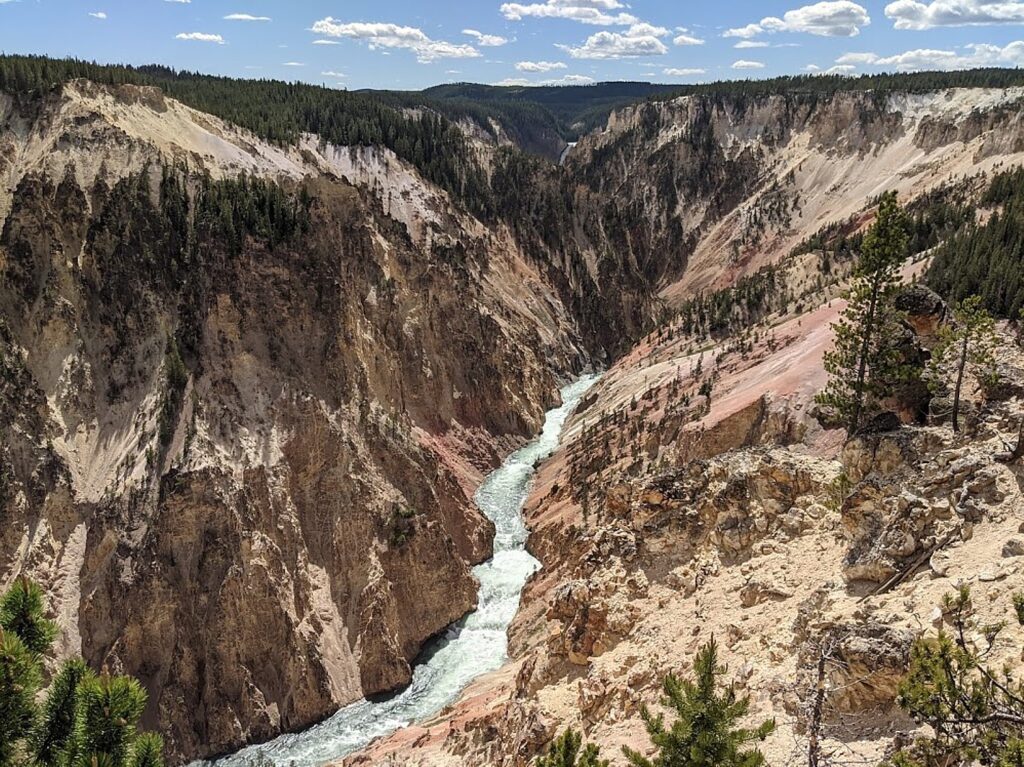
On the way back to Gardiner, we stop at Swan Lake Flat, for one of the famous views to the Gallatin Mountains. And at the last turn out of the park, we spot an American Eagle perched on a rock.
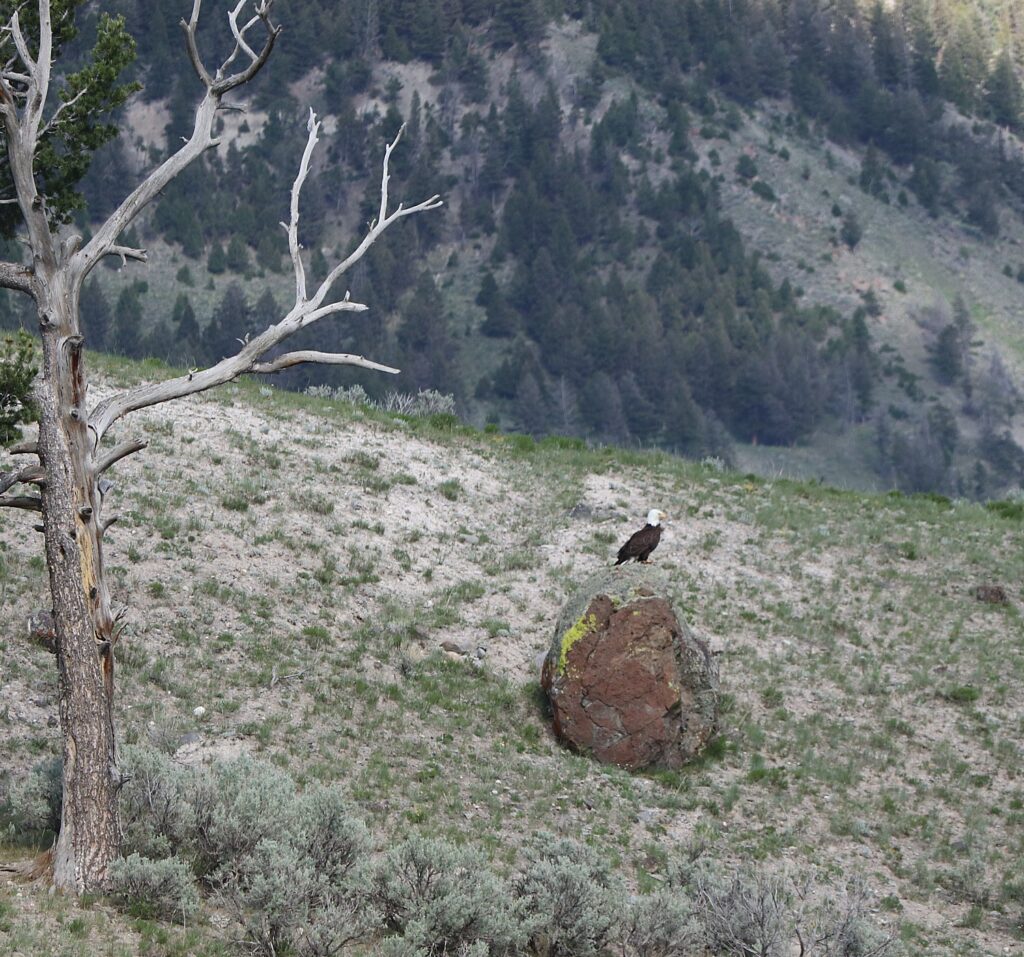
We are very content with our lodging in Gardiner, a cabin at the 406 Lodge. Our cabin has two queen beds, a living room and kitchenette, and is walking distance to shops and restaurants (Subway, located just across the bridge from us and open until 10 pm, is ideal to purchase the next day’s picnic lunch) and a few short blocks to the North entrance to Yellowstone (little line up here). (406 Lodge, 204 3rd St South, Gardiner, MT, 59030, 800-246-8357).
See also:
Yellowstone National Park in Two Days: Mother Nature Gets Surreal
______________________
© 2021 Travel Features Syndicate, a division of Workstyles, Inc. All rights reserved. Visit goingplacesfarandnear.com, www.huffingtonpost.com/author/karen-rubin, and travelwritersmagazine.com/TravelFeaturesSyndicate/. Blogging at goingplacesnearandfar.wordpress.com and moralcompasstravel.info. Send comments or questions to [email protected]. Tweet @TravelFeatures. ‘Like’ us at facebook.com/NewsPhotoFeatures


One thought on “Yellowstone National Park in Two Days: Day 1: ‘Random Boiling Earth’”
Comments are closed.